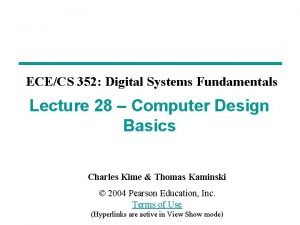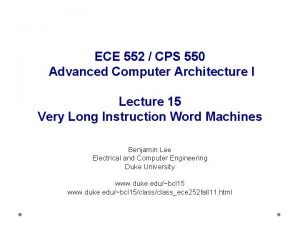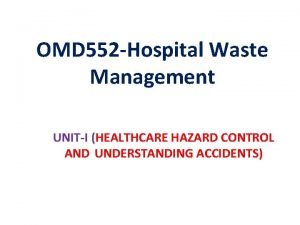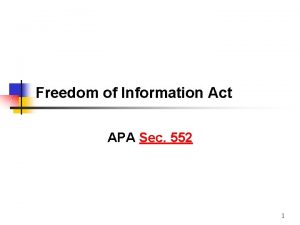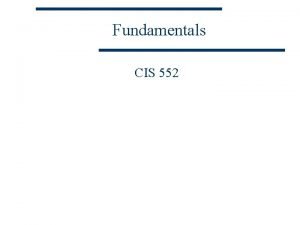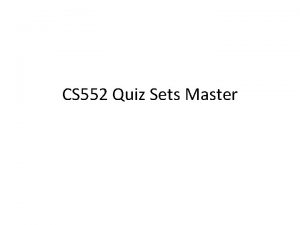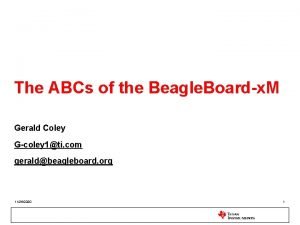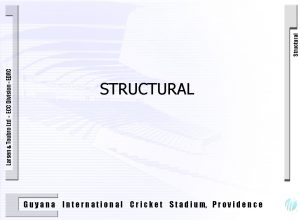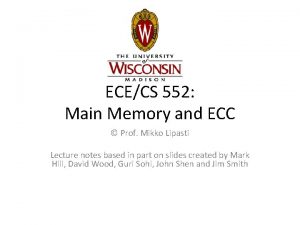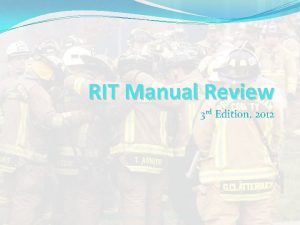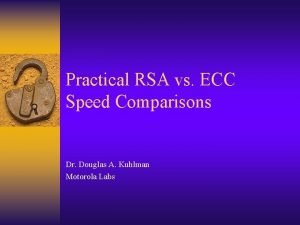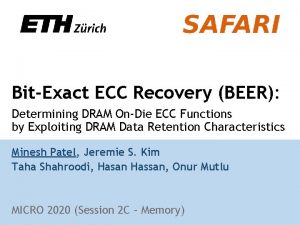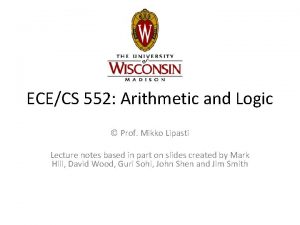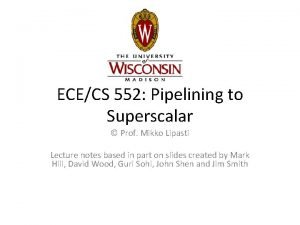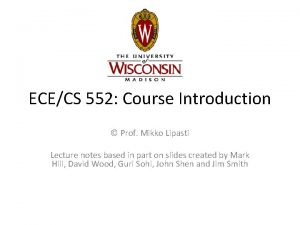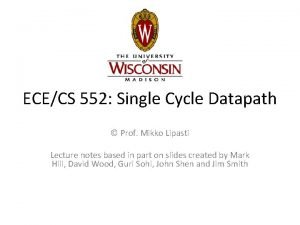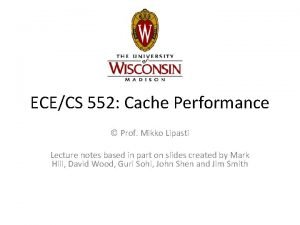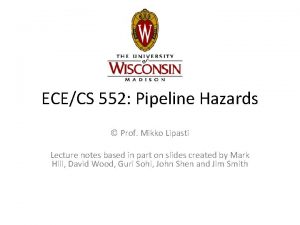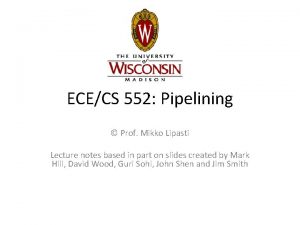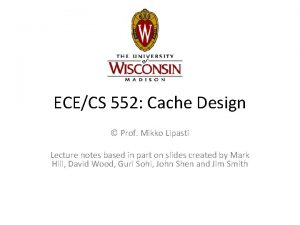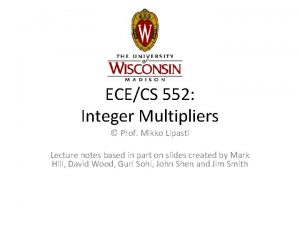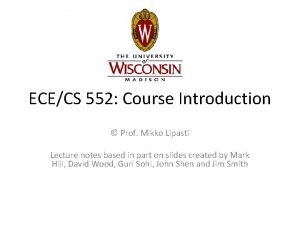ECECS 552 Main Memory and ECC Prof Mikko


















- Slides: 18

ECE/CS 552: Main Memory and ECC © Prof. Mikko Lipasti Lecture notes based in part on slides created by Mark Hill, David Wood, Guri Sohi, John Shen and Jim Smith

Memory Hierarchy On-Chip SRAM Off-Chip SRAM DRAM SPEED and COST CAPACITY Registers Disk 2

Main Memory Design • Commodity DRAM chips • Wide design space for – Minimizing cost, latency – Maximizing bandwidth, storage • Susceptible to soft errors – Protect with ECC (SECDED) – ECC also widely used in on-chip memories, busses 3

DRAM Chip Organization • • Optimized for density, not speed • Read entire row at once (RAS, page open) Data stored as charge in capacitor • Read word from row (CAS) Discharge on reads => destructive reads • Charge leaks over time • – refresh every 64 ms Burst mode (sequential words) Write row back (precharge, page close) 4

Main Memory Design Single DRAM chip has multiple internal banks 5

Main Memory Access • Each memory access (DRAM bus clocks, 10 x CPU cycle time) – 5 cycles to send row address (page open or RAS) – 1 cycle to send column address – 3 cycle DRAM access latency – 1 cycle to send data (CAS latency = 1+3+1 = 5) – 5 cycles to send precharge (page close) – 4 word cache block • One word wide: (r=row addr, c= col addr, d=delay, b=bus, p=precharge) rrrrrcdddbcdddbppppp – 5 + 4 * (1 + 3 + 1) = 25 cycles delay – 5 more busy cycles (precharge) till next command 6

Main Memory Access • One word wide, burst mode (pipelined) rrrrrcdddb b b bppppp – 5 + 1 + 3 + 4 = 13 cycles – Interleaving is similar, but words can be from different rows, each open in a different bank • Four word wide memory: rrrrrcdddbppppp – 5 + 1 + 3 + 1 = 9 cycles 7

Error Detection and Correction • Main memory stores a huge number of bits – Probability of bit flip becomes nontrivial – Bit flips (called soft errors) caused by • • Slight manufacturing defects Gamma rays and alpha particles Electrical interference Etc. – Getting worse with smaller feature sizes • Reliable systems must be protected from soft errors via ECC (error correction codes) – Even PCs support ECC these days 8

Error Correcting Codes • Probabilities: P(1 word no errors) > P(single error) > P(two errors) >> P(>2 errors) • Detection - signal a problem • Correction - restore data to correct value • Most common – Parity - single error detection – SECDED - single error correction; double error detection • Supplemental reading on course web page! 9

ECC Codes for One Bit Power Correct #bits Comments Nothing 0, 1 1 SED 00, 11 2 01, 10 detect errors SEC 000, 111 3 SECDED 0000, 1111 4 001, 010, 100 => 0 110, 101, 011 => 1 One 1 => 0 Two 1’s => error Three 1’s => 1 10

ECC # 1’s 0 Result 0 1 0 2 Err 3 1 4 1 • Hamming distance – No. of bit flips to convert one valid code to another – All legal SECDED codes are at Hamming distance of 4 • I. e. in single-bit SECDED, all 4 bits flip to go from representation for ‘ 0’ (0000) to representation for ‘ 1’ (1111) 11

ECC • Reduce overhead by applying codes to a word, not a bit – Larger word means higher p(>=2 errors) # bits SED overhead SECDED overhead 1 1 (100%) 3 (300%) 32 1 (3%) 7 (22%) 64 1 (1. 6%) 8 (13%) n 1 (1/n) 1 + log 2 n + a little 12

64 -bit ECC • 64 bits data with 8 check bits dddd…. . dccccc • DIMM with 9 x 8 -bit-wide DRAM chips = 72 bits • Intuition – One check bit is parity – Other check bits point to • Error in data, or • Error in all check bits, or • No error 13

ECC • To store (write) – Use data 0 to compute check 0 – Store data 0 and check 0 • To load – Read data 1 and check 1 – Use data 1 to compute check 2 – Syndrome = check 1 xor check 2 • I. e. make sure check bits are equal 14

ECC Syndrome Parity Implications 0 OK data 1==data 0 n != 0 Not OK Flip bit n of data 1 to get data 0 n != 0 OK Signals uncorrectable error 15

4 -bit SECDED Code Bit Position 001 Codeword C 1 C 2 b 1 C 3 b 2 b 3 b 4 P C 1 X C 2 010 011 X X 101 X 110 X X C 3 P 100 111 X X X • Cn parity bits chosen specifically to: – – Identify errors in bits where bit n of the index is 1 C 1 checks all odd bit positions (where LSB=1) C 2 checks all positions where middle bit=1 C 3 checks all positions where MSB=1 • Hence, nonzero syndrome points to faulty bit 16

4 -bit SECDED Example Bit Position 1 2 3 4 5 6 7 Codeword C 1 C 2 b 1 C 3 b 2 b 3 b 4 P Original data 1 0 1 0 0 Syndrome No corruption 1 0 1 0 0 0, P ok 1 bit corrupted 1 0 0 0 1 1, P !ok 2 bits corrupted 1 0 0 1 1 0, P ok • 4 data bits, 3 check bits, 1 parity bit • Syndrome is xor of check bits C 1 -3 – If (syndrome==0) and (parity OK) => no error – If (syndrome != 0) and (parity !OK) => flip bit position pointed to by syndrome – If (syndrome != 0) and (parity OK) => double-bit error 17

Summary • Commodity DRAM chips • Wide design space for – Minimizing cost, latency – Maximizing bandwidth, storage • Susceptible to soft errors – Protect with ECC (SECDED) – ECC also widely used in on-chip memories, busses 18
